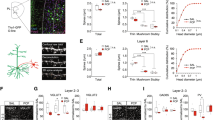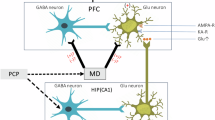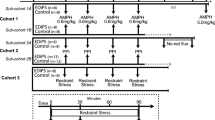Abstract
D-amphetamine (AMPH) and phencyclidine (PCP) can induce a model psychosis that mimic the positive symptoms of schizophrenia, but only PCP also mimics the negative symptoms. Recent studies in the rat social interaction test have shown that PCP, and not AMPH, induce social withdrawal following single and repeated injections, and this effect may, therefore, be used to model negative symptoms. However, an AMPH psychosis is usually only seen after a prolonged period of repeated injections or continuous administration for 3–5 days of high doses of AMPH. It is, therefore, possible that in these studies, AMPH was administered at insufficient levels in rats, and this may explain its lack of effect. The present study has determined the effects of continuous administration of AMPH (23 to 94 μmol/kg/day; 4.2 to 17 mg/kg/day) and PCP (18 to 107 μmol/kg/day; 5.0 to 30 mg/kg/day) in rats after five days of infusion in the social interaction test and after 6–7 days in standard activity cages. The study found that AMPH and PCP dose-dependently induced stereotyped behaviour and locomotor hyperactivity, behaviours believed to be related to positive symptoms, and that only PCP induced social withdrawal. These findings confirm previous studies that only PCP and not AMPH induce deficits in the social behaviour of rats.
Similar content being viewed by others
Log in or create a free account to read this content
Gain free access to this article, as well as selected content from this journal and more on nature.com
or
References
Angrist BM, Gershon S . (1970): The phenomenology of experimentally induced amphetamine psychosis-preliminary observations. Am J Psychiatr 2: 95–107
Bell DS . (1965): Comparison of amphetamine psychosis and schizophrenia. Br J Psychiatr 111: 701–707
Bell DS . (1973): The experimental reproduction of amphetamine psychosis. Arch Gen Psychiatr 29: 35–40
Castellani S, Adams PM . (1981): Acute and chronic phencyclidine effects on locomotor activity, stereotypy and ataxia in rats. Eur J Pharmacol 73: 143–154
Connell PH . (1958): Amphetamine psychosis. London, Chapman & Hall
Corbett R, Camacho F, Woods AT, Kerman LL, Fishkin RJ, Brooks K, Dunn RW . (1995): Antipsychotic agents antagonize non-competitive N-methyl-d-asparate antagonist-induced behaviors. Psychopharmacology 120: 67–74
Davies BM, Beech HR . (1960): The effects of 1-arylcyclohexylamine (sernyl) on twelve normal volunteers. J Mental Sci 106: 912–914
Ellenbroek BA, Willemen APM, Cools AR . (1989): Are antagonists of dopamine d1 receptors drugs that attenuate both positive and negative symptoms of schizophrenia? a pilot study in java monkeys. Neuropsychopharmacology 2: 191–199
Ellison G, Eison MS, Huberman HS . (1978): Stages of constant amphetamine intoxication: Delayed appearance of abnormal social behaviors in rat colonies. Psychopharmacology 56: 293–299
File SE . (1988): How good is social Interaction as a test of anxiety? Animal Models Psychiatr Dis 1: 151–166
Gambil JD, Kornetsky C . (1976): Effects of chronic d-amphetamine on social behavior of the rat: Implications for an animal model of paranoid schizophrenia. Psychopharmacology 50: 215–223
Gately PF, Segal DS, Geyer MA . (1987): Sequential changes in behavior induced by continuous infusion of amphetamine in rats. Psychopharmacology 91: 217–220
Geyer M, Swerdlow NR, Mansbach RS, Braff DL . (1990): Startle response models of sensorimotor gating and habituation deficits in schizophrenia. Brain Res Bull 25: 485–498
Greifenstein FE, Yoshitake J, DeValut M, Gajewski JE . (1958): A Study of 1-aryl cyclo hexyl amine for anesthesia. Anesth Analg 37: 283–294
Griffith JD, Cavanaugh J, Held J, Oates JA . (1972): Dextroamphetamine. Arch Gen Psychiatr 26: 97–100
Guy AP, Gardner CR . (1985): Pharmacological characterisation of a modified social interaction model of anxiety in the rat. Neuropsychobiol. 13: 194–200
Huitema BE . (1980): The analysis of covariants and alternatives. New York, Wiley & Sons
Javitt DC, Zukin SR . (1991): Recent advances in the phencyclidine model of schizophrenia. Am J Psychiatry 148: 1301–1308
Jackson DM, Johansson C, Lindgren LM, Bengtson A . (1994): Dopamine receptor anatagonists block amphetamine and phencyclidine-induced motor stimulation in rats. Pharmacol Biochem Behav 41: 465–471
Lyon M . (1991): Animal models of mania and schizophrenia. In Willner P (ed), Behavioural Models in Psychopharmacology: Theoretical, Industrial and Clinical Perspectives. Cambridge, Cambridge University Press, pp. 253–310
Meltzer HY . (1991): The mechanism of action of novel antipsychotic drugs. Schiz Bull 17: 262–287
Miczek KA, Woolley J, Schlisserman S, Yoshimura H . (1981): Analysis of amphetamine effects on agonistic and affiliative behavior in squirrel monkeys saimiri-sciureus. Pharmacol Biochem Behav 14: 103–108
Nielsen EB . (1981): Rapid decline of stereotyped behavior in rats during constant 1 week administration of amphetamine via implanted alzet osmotic mini pumps. Pharmacol Biochem Behav 15: 161–166
Nielsen EB, Lyon M, Ellison G . (1983): Apparent hallucinations in monkeys during around-the-clock amphetamine for seven to fourteen days. J Nerv Mental Dis 171: 222–233
Robinson TE, Becker JB . (1986): Enduring changes in brain and behavior produced by chronic amphetamine administration: A review and evaluation of animal models of amphetamine psychosis. Brain Res Rev 11: 157–198
Sams-Dodd F . (1995a): Distinct effects of d-amphetamine and phencyclidine on the social behaviour of rats. Behav Pharmacol 6: 55–65
Sams-Dodd F . (1995b): Automation of the social interaction test by a video tracking system: Behavioural effects of repeated phencyclidine treatment. J Neurosci Meth 59: 157–168
Sams-Dodd F . (1996): Phencyclidine-induced stereotyped behaviour and social isolation in the rat: A possible animal model of schizophrenia. Behav Pharmacol 7: 3–23
Sams-Dodd F . (1997): Effect of novel antipsychotic drugs on PCP-induced stereotyped behaviour and social isolation in the rat social interaction test. Behav Pharmacol 8: 196–215
Sams-Dodd F, Newman JD . (1997): Effects of administration regime on the psychotomimetic properties of d-amphetamine in the squirrel monkey (Saimiri sciureus). Pharmacol Biochem Behav 56: 471–480
Scaggs PR, Ridley RM . (1979): The effects of dopamine and noradrenaline blockade on amphetamine-induced behavior in the marmoset. Psychopharmacology 62: 41–45
Schiörring E . (1997): Changes in individual and social behavior by amphetamine and related compounds in monkeys and man. In Ellinwood EH, Kilbey MM (eds), Cocaine and Other Stimulants. New York, Plenum Press, pp. 481–522
Siegel RK . (1978): Phencyclidine and ketamine intoxication a study of 4 populations of recreational users. In Peterson RC, Stillman RC (eds), National Institute of Drug Abuse Research Monograph #21. Washington DC, NIH Press, pp. 119–147
Snyder SH . (1973): Amphetamine psychosis: A “model” schizophrenia mediated by catecholamines. Am J Psychiatr 130: 61–67
Acknowledgements
I thank Ms. Marit Pedholt Gitz, Mr. Nicolai L. Steffensen, and Ms. Pi Ørum for their technical assistance in conducting these experiments, and Dr. Jørn Arnt and Mrs. Jeanette Sams-Dodd for commenting on the manuscript.
Author information
Authors and Affiliations
Rights and permissions
About this article
Cite this article
Sams-Dodd, F. Effects of Continuous D-Amphetamine and Phencyclidine Administration on Social Behaviour, Stereotyped Behaviour, and Locomotor Activity in Rats. Neuropsychopharmacol 19, 18–25 (1998). https://doi.org/10.1016/S0893-133X(97)00200-5
Received:
Revised:
Accepted:
Issue date:
DOI: https://doi.org/10.1016/S0893-133X(97)00200-5
Keywords
This article is cited by
-
Neonatal phencyclidine as a model of sex-biased schizophrenia symptomatology in adolescent mice
Psychopharmacology (2023)
-
Amphetamine maintenance therapy during intermittent cocaine self-administration in rats attenuates psychomotor and dopamine sensitization and reduces addiction-like behavior
Neuropsychopharmacology (2021)
-
Adverse neuropsychiatric development following perinatal brain injury: from a preclinical perspective
Pediatric Research (2019)
-
The Effects of Housing Density on Social Interactions and Their Correlations with Serotonin in Rodents and Primates
Scientific Reports (2018)
-
Diazepam blocks 50 kHz ultrasonic vocalizations and stereotypies but not the increase in locomotor activity induced in rats by amphetamine
Psychopharmacology (2018)



